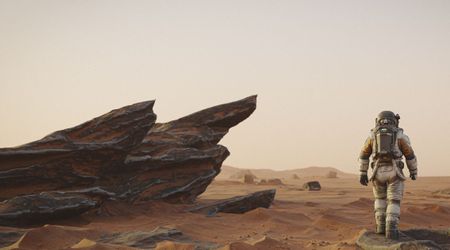How many rovers are on Mars?


As of January 2023, there are 3 rovers currently in operation on Mars: Curiosity, Perseverance and Zhurong. The red planet is tantalizing for many reasons: its history is similar to Earth’s, gravity on Mars is 38% that of Earth’s — adequate for humans to adapt to, and it has a protective although thin atmosphere.
These reasons make Mars the next best planet to live on. But before humans can travel to Mars, we need to know all about what it takes to set up camp and survive there for a long time. To gather this information, astronomers have sent rovers, landers and orbiters that scan Mars’ atmosphere, pick up and analyze its surface material to piece together its past, and the potential for life and habitability.
Because communication between Mars and Earth takes anywhere between 4 and 20 minutes, the scientists had to imbibe artificial intelligence into these robots so that they could sense obstacles and navigate the terrain smoothly.
Let's dive deeper into the ongoing missions exploring Mars, as well as the previous rovers and landers that have landed on the red planet.

An artist’s conception of an orbiter with a rover inside approaching Mars. Source: NASA
Rovers and landers currently active on Mars
1 - Curiosity (rover)
Curiosity is a car-sized rover that was launched from the Cape Canaveral Air Force Station on November 26, 2011, and touched down on Mars on August 06, 2012. Although initially expected to operate for one full Martian year, or 687 Earth days, this rover exceeded its life span and continues to work in full-swing roughly 8 years later (its 3,000th day anniversary was on January 12, 2021).

A dust-covered Curiosity took its selfie to mark 8 years on Mars. Source: NASA
Mission goals and instruments
The main reason Curiosity was sent to Mars was to understand Mars’ potential to host microbial life. The rover does this through its expansive set of scientific instruments — the most advanced ever sent to Mars, by scooping loose surface soil and drilling Martian rocks to analyze its structure and composition.
In fact, you might have noticed Curiosity’s rectangular “head” and its eye-like feature. That’s actually Curiosity’s laser, which it has learned to use autonomously. It selects a rock on its own, shoots its sharp laser, and analyzes the resulting vapor.

Artist’s concept of Curiosity shooting a laser into a Martian rock. Source: NASA
Discoveries made by Curiosity
Curiosity found that the Gale Crater could have hosted life 3.5 billion years ago when the red planet had an atmosphere thicker than it does today. The rover also discovered that the remains of an ancient lake called Yellowknife Bay are neither too acidic nor too salty — a comfortable scenario for life to flourish.
What Curiosity hasn’t been able to solve to date is the abundance of methane — as much as 1 part methane in two billion parts of Martian air. But the rover has survived and worked through a dust storm that had enveloped the entire planet and reduced the sunlight by 97%, so there’s strong hope for many more discoveries.
You can follow curiosity's mission on its Twitter account for live updates.
Curiosity Information & Facts
- Mission name: Mars Science Laboratory.
- Launched: November 26, 2011.
- Arrived on Mars: August 6, 2012.
- Mission status: Active.
- Rover weight: 1,982 pounds (899 kg).
- Rover size: 10 feet (3 meters) long, 9 feet (2.7 meters) wide, 7 feet (2.2 meters) high.
- Power source: Multi-mission radioisotope thermoelectric generator (MMRTG).
- Mobility: 6x 50 cm (20 in) diameter wheel drive with a rocker-bogie suspension system.
- Maximum speed: 0.14km/h (0.08m/h).
- Science instruments: MastCam, ChemCam, Navcams, REMS, Hazcams, MAHLI, APXS, CheMin, SAM, DRT, RAD, DAN, MARDI.
- Mission objective: To determine if Mars is, or was, suitable for life.
- Rover cost: $2.53 billion.
2 - Perseverance (rover)
NASA’s latest rover on the Martian world is Perseverance, which was launched on July 30, 2020, and touched on Mars on February 18, 2021 (watch the landing here). This mission also carried with it a “marscopter” — a helicopter to test powered flight on Mars.
A 3D visualisation of NASA’s Perseverance Rover
Mission goals and instruments
The mission’s goal is to look for signs of past life on Mars as well as scan the red planet for the potential for habitability for humans. To reach that goal, Perseverance is testing the capability to produce oxygen from the Martian atmosphere and locate possible subsurface water regions for future human expeditions.
Related: Read my in-depth Q&A about Perseverance (50+ answers about the rover).
Discoveries made by Perseverance
Perseverance has only been on Mars for 32 sols (Martian solar days). While there aren’t significant scientific discoveries yet, the rover has already recorded more than 16 minutes of audio of itself moving on Mars, marking the first time for a Martian rover to do so.
You can listen to the raw, unfiltered audio here.
You can follow Perseverance's mission on its Twitter account for live updates.
Perseverance Information & Facts
- Mission name: Mars 2020.
- Launched: July 30, 2020.
- Arrived on Mars: February 18, 2021.
- Mission status: Active.
- Rover weight: 2,260 pounds (1,025 kg).
- Rover size: 10 feet (3 meters) long, 9 feet (2.7 meters) wide, 7 feet (2.2 meters) high.
- Power source: Multi-mission radioisotope thermoelectric generator (MMRTG).
- Mobility: 6x 50 cm (20 in) diameter wheel drive with a rocker-bogie suspension system.
- Maximum speed: 0.12km/h (0.07m/h).
- Science instruments: Mastcam-Z, Mars Environmental Dynamics Analyzer (MEDA)Mars Oxygen ISRU Experiment (MOXIE). Planetary Instrument for X-ray Lithochemistry (PIXL), Radar Imager for Mars' Subsurface Experiment (RIMFAX), Scanning Habitable Environments with Raman & Luminescence for Organics & Chemicals (SHERLOC), SuperCam.
- Mission objective: To seek signs of past microbial life and to collect samples for future return to Earth.
- Rover cost: $2.7 billion (including the cost of the Atlas V launch vehicle)
3 - Zhurong (rover)
On May 22nd, 2021, the Zhurong rover landed on the martian surface (Utopia Planitia). This constitutes China's first successful mission on Mars. The rover is equipped with an array of equipment designed to study the red planet's surface composition, its magnetic field, its geological features as well as its ice water distribution. In short, the Zhurong rover will try to learn more about what Mars looked like in the past. Zhurong is equipped with a laser to burn nearby rocks in order to assess their chemistry
The mission is thought to last for 90 days but rovers on Mars have a history of lasting for much longer than their intended lifespan... Good luck Zhurong!
You can follow Zhurong's mission on this Twitter (fan) account for live updates.
Zhurong Information & Facts
- Mission Name: Tianwen-1
- Launched: 23 July 2020
- Arrived on Mars: 14 May 2021
- Mission status: Active (as of January 20, 2023)
- Rover weight: 529 pounds (240 kilograms).
- Rover size: 2.6 m × 3 m × 1.85 m (8 ft 6 in × 9 ft 10 in × 6 ft 1 in)
- Power source: Solar arrays
- Mobility: six wheels that are independently driven.
- Maximum speed: 0.2 km/h (0.12 mph)
- Science instruments: MarSCoDe; MCS; MSCam; NaTeCam; RoMAG; RoPeR
- Mission objective: To study the geology, atmosphere, and environment of Mars.
- Rover cost: Unknown

Zhurong next to its lander. Credits: China National Space Administration
Former Mars rovers and landers (no longer active)
| Name |
Launch |
Landing |
Lifespan |
Mission |
Discoveries |
|---|---|---|---|---|---|
| Mars 3 | May 28, 1971 | December 2, 1971 | Roughly 20 seconds | Successful landing, but lost contact after 20 seconds | None |
| Viking 1 | August 20, 1975 | July 20, 1976 | 6 years, 116 days | The first successful landing of a rover on a Martian world. Viking 1 was planned to work for only 90 days after landing, but continued to work for over half a decade. | The rover’s main goal was to hunt for evidence of life near its landing site, but it couldn’t find any. It did help scientists better understand Mars as a cold planet with ancient river beds and a surface that would have witnessed vast amounts of flooding. |
| Viking 2 | September 09, 1975 | September 3, 1976 | 3 years 6 months | To look for life, similar to Viking 1. | Along with Viking 1, Viking 2 returned 4,500 images of just the landing site and more than 50,000 while mapping 97% of the Martian surface. Similar to Viking 1, this rover too was hunting for past life but couldn’t find any conclusive evidence. It had to be put to rest in 1980 after its batteries died. |
| Sojourner | December 04, 1996 | July 4, 1997 | 85 days | To demonstrate low-cost technology and collect data | The lander returned home 16,500 images and 8.5 million measurements of atmospheric pressure and temperature, as well as wind. From the images and measurements, scientists deduced the size of Martian atmospheric particles. |
| Spirit | June 10, 2003 | January 03, 2004 | 6 years, 77 days | To look for past life | The rover showed that Mars’s surface was much more complex geologically than previously thought. It also captured dust devils as they happened. It suffered through a major storm in 2007 summer, and communication officially ceased in 2010 because the temperature was thought to be too cold for it to function. |
| Opportunity | July 08, 2003 | January 24, 2004 | 15 Earth years | To look for past life, landed on the other side of the planet from Spirit. | Found at least one local Martian area that might have hosted microbial life. We lost contact with it on June 10, 2018, because a dust storm ceased communications |
| Phoenix | August 04, 2007 | May 25, 2008 | 161 days | To take note of local habitability and to search for signs of water | The region where Pheonix landed was relatively flat and shaped into polygons. It assessed the Martian weather and observed snowfall on at least one occasion. It also confirmed that water-ice exists below the Martian surface. |
InSight (inactive lander)
While previous missions to Mars had looked at the Martian surface features, NASA’s InSight lander did the “first thorough check-up” since the planet’s formation. Launched on May 05, 2018, and landed on Mars on November 26 the same year, InSight did not analyze soil samples but looked deep within Mars — its crust, core, and mantle.
InSight tracked the tectonic activity on Mars to detect “marsquakes” and meteorite impacts.

NASA’s InSight lander on the Martian surface. Source: NASA
Mission goals and instruments
InSight’s goal was to understand how rocky celestial bodies such as our solar system’s 4 inner planets evolved since their formation by looking at the planet’s “vital signs” such as seismology and temperature.
Discoveries made by InSight
In its first year itself, InSight detected roughly 450 marsquakes — more frequent and much milder than what the scientists expected. Since the red planet does not have tectonic plates like Earth does to cause marsquakes, scientists think the volcanically active regions are causing them.
While the Martian magnetic field that was once strong no longer exists today, InSight detected a magnetic field 10 times stronger than expected in the surface rocks that were magnetized from Mars’ early history. The lander also sensed almost unceasing whirlwinds, the sound of which it captured.
You can listen to these Martian winds via the audio player below.
In December 2022, NASA's InSight mission ended after more than four years of collecting data on Mars. It seems that over the years, a large amount of dust has piled up on top of InSight's solar panel, limiting its ability to recharge its battery.
Mission controllers at NASA's Jet Propulsion Laboratory (JPL) in Southern California were unable to contact the lander after two consecutive attempts, leading them to conclude the spacecraft's solar-powered batteries have run out of energy.
Conclusion
While the total of 11 robots (6 rovers and 5 landers) sent to Mars had different instruments, varying mission durations, and had landed in different regions on Mars, all of them have a common goal: to assess Mars’ habitability both in the past and for the future, as humans plan to establish settlements on the red planet.
These rovers are scanning, drilling, and traveling on the Martian world in order to accumulate knowledge about the red planet on our behalf. We will use that knowledge when we go to Mars — a world that is so similar to Earth in its history that it is thought to be the next best planet for potential life and habitability.
The next rover scheduled to land on Mars is the "Rosalind Franklin" Rover, a joint mission between the European Space Agency and the Russian Roscosmos State Corporation. The ExoMars mission launch is currently planned for 2022. You can keep up to date with the latest mission news on ExoMars's website.









